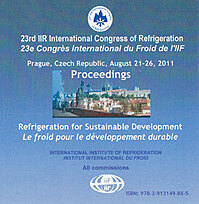
Document IIF
Un algorithme en temps réel pour déterminer la haute pression optimale des systèmes au R744.
A real-time algorithm for determining R744 systems optimal high pressure.
Numéro : pap. ID: 487
Auteurs : CECCHINATO L., CORRADI M., COSI G., et al.
Résumé
In this paper the optimal energy efficiency and heat rejection pressure problem in single stage refrigeration carbon dioxide vapour compressor units operating in transcritical conditions is addressed. A real-time model based optimisation algorithm for determining the optimal (or quasi-optimal) pressure value is developed as a more efficient and robust solution than literature approximated solutions to the optimisation problem. The problem is solved based on a model estimating the system performance and on the system boundary conditions measurements. The system model is obtained by an on-line artificial neural network system identification technique and the optimisation problem is solved by a particle swarm optimisation technique. The proposed algorithm performance is dynamically tested by simulation considering the performance of a carbon dioxide heat pump water heater with supply water temperature control. It appears to successfully approximate the optimal heat rejection pressure values showing an average daily pressure deviation of 0.9 10^5 Pa over a two year simulation period. The corresponding cumulated energy consumption penalisation is 1.1%.
Documents disponibles
Format PDF
Pages : 9 p.
Disponible
Prix public
20 €
Prix membre*
Gratuit
* meilleur tarif applicable selon le type d'adhésion (voir le détail des avantages des adhésions individuelles et collectives)
Détails
- Titre original : A real-time algorithm for determining R744 systems optimal high pressure.
- Identifiant de la fiche : 30003206
- Langues : Anglais
- Source : Proceedings of the 23rd IIR International Congress of Refrigeration: Prague, Czech Republic, August 21-26, 2011. Overarching theme: Refrigeration for Sustainable Development.
- Date d'édition : 21/08/2011
Liens
Voir d'autres communications du même compte rendu (569)
Voir le compte rendu de la conférence
Indexation
-
Influence factors in performance of the two-sta...
- Auteurs : ALMEIDA I. M. G., BARBOSA C. R. F.
- Date : 21/08/2011
- Langues : Anglais
- Source : Proceedings of the 23rd IIR International Congress of Refrigeration: Prague, Czech Republic, August 21-26, 2011. Overarching theme: Refrigeration for Sustainable Development.
- Formats : PDF
Voir la fiche
-
Determinazione della pressione ottimale nei sis...
- Auteurs : CECCHINATO L., CORRADI M., MINETTO S., et al.
- Date : 12/06/2009
- Langues : Anglais
- Source : Latest technologies in refrigeration and air conditioning: energy issues and climate change, new refrigerants, new European regulations, new plants, the cold chain. XIII European Conference: June 12-13, 2009, Milan.
- Formats : PDF
Voir la fiche
-
Novel rotary pressure exchanger for highly effi...
- Auteurs : THATTE A., FRICKE B., NAWAZ K.
- Date : 13/06/2022
- Langues : Anglais
- Source : 15th IIR-Gustav Lorentzen Conference on Natural Refrigerants (GL2022). Proceedings. Trondheim, Norway, June 13-15th 2022.
- Formats : PDF
Voir la fiche
-
Optimum performance of external intercooling tw...
- Auteurs : MARTÍNEZ-BALLESTER S., GONZÁLVEZ-MACIÁ J., CORBERÁN J. M.
- Date : 21/08/2011
- Langues : Anglais
- Source : Proceedings of the 23rd IIR International Congress of Refrigeration: Prague, Czech Republic, August 21-26, 2011. Overarching theme: Refrigeration for Sustainable Development.
- Formats : PDF
Voir la fiche
-
Energy impact of the superheat associated to a ...
- Auteurs : LLOPIS R., SÁNCHEZ E., CABELLO R., et al.
- Date : 13/06/2010
- Langues : Anglais
- Source : IIR/Eurotherm sustainable refrigeration and heat pump technology conference. Proceedings of the Eurotherm Seminar No. 88, Stockholm, Sweden, June 13-16, 2010.
- Formats : PDF
Voir la fiche
